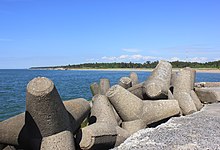Tetrapod (structure)
Graciosa Island, Azores


A tetrapod is a form of
Invention
Tetrapods were originally developed in 1950 by Pierre Danel and Paul Anglès d'Auriac of Laboratoire Dauphinois d'Hydraulique (now
Adoption
Tetrapods have become popular across the world, particularly in
Okinawa, a popular vacation destination in Japan, has made it difficult for tourists to find unaltered beaches and shoreline, especially in the southern half of the island.[6]
Similar designs
See also
- Artificial reef – Human-made underwater structure that functions as a reef
- Breakwater (structure) – Coastal defense structure
- Coastal management – Preventing flooding and erosion of shorelines
- Coastal erosion – Displacement of land along the coastline
- Ocean surface wave– Surface waves generated by wind on open water
- Riprap – Rock or concrete protective armour
- Seawall – Form of coastal defence
References
- ^ "What are Tetrapods? (Tetrapods Resist Wave Impact and Prevent Beach Erosion)". Brighthub Engineering. Retrieved 2017-08-02.
- ^ Park, Sang Kil; et al. (2014). "Effects of vertical wall and tetrapod weights on wave overtopping in rubble mound breakwaters under irregular wave conditions" (PDF). Retrieved 2 August 2014.
- ^ Pierre Danel and Paul Anglès d'Auriac (1963) Improvements in or relating to artificial blocks for building structures exposed to the action of moving water [1]
- ISSN 2156-1028.
- ^ Danel, Pierre (1967). "The Tetrapod". Retrieved 2 August 2017.
- ISSN 0447-5763. Retrieved 2017-08-02.
- .
Further reading
- Lagasse, P.F. (2007). Countermeasures to protect bridge piers from scour. Washington, D.C.: Transportation Research Board. ISBN 978-0-309-09909-7.
- Hesse, Stephen. "The Japan Times environment columnist". Don't You Just Love 'Em ... Tetrapods. The Japan Times. Retrieved 13 May 2011.
- Zimmerman, Claus, ed. (2005). Environmentally friendly coastal protection : proceedings of the NATO Advanced Research Workshop on Environmentally Friendly Coastal Protection Structures, Varna, Bulgaria, 25-27 May 2004 (Online-Ausg. ed.). Dordrecht: Springer. ISBN 978-1-4020-3299-8.
- Wijers-HasegawaHesse, Yumi. "Tetrapodistas: Beauty beheld in huge concrete forms". The Japan Times.
- Hesse, Stephen. "Loving and Loathing Japan's Concrete Coasts, Where Tetrapods Reign". The Asia-Pacific Journal: Japan Focus.
Wikimedia Commons has media related to Tetrapods.

